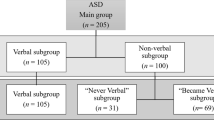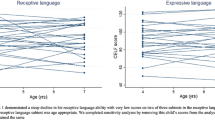Abstract
Children with autism spectrum disorder (ASD) and structural language impairment (LI) may be at risk of more adverse social-developmental outcomes. We examined trajectories of early social competence (using the Vineland-II) in 330 children aged 2–4 years recently diagnosed with ASD, and compared 3 subgroups classified by: language impairment (ASD/LI); intellectual disability (ASD/ID) and ASD without LI or ID (ASD/alone). Children with ASD/LI were significantly more socially impaired at baseline than the ASD/alone subgroup, and less impaired than those with ASD/ID. Growth in social competence was significantly slower for the ASD/ID group. Many preschool-aged children with ASD/LI at time of diagnosis resembled “late talkers” who appeared to catch up linguistically. Children with ASD/ID were more severely impaired and continued to lag further behind.

Similar content being viewed by others
References
American Psychiatric Association (APA). (2000). Diagnostic and statistical manual of mental disorders (4th ed., text rev.). Washington, DC: Author.
American Psychiatric Association (APA). (2013). Diagnostic and statistical manual of mental disorders (5th ed.). Arlington, VA: American Psychiatric Publishing.
Anderson, D. K., Oti, R. S., Lord, C., & Welch, K. (2009). Patterns of growth in adaptive social abilities among children with autism spectrum disorders. Journal of Abnormal Child Psychology, 37(7), 1019–1034. doi:10.1007/s10802-009-9326-0.
Astington, J. W., & Jenkins, J. M. (1999). A longitudinal study of the relation between language and theory-of-mind development. Developmental Psychology, 35(5), 1311–1320.
Bennett, T., Szatmari, P., Bryson, S., Duku, E., Vaccarella, L., & Tuff, L. (2013). Theory of mind, language and adaptive functioning in ASD: A neuroconstructivist perspective. J Can Acad Child Adolesc Psychiatry, 22(1), 13–19.
Bennett, T., Szatmari, P., Bryson, S., Volden, J., Zwaigenbaum, L., Vaccarella, L., et al. (2008). Differentiating autism and Asperger syndrome on the basis of language delay or impairment. Journal of Autism and Developmental Disorders, 38(4), 616–625. doi:10.1007/s10803-007-0428-7.
Billstedt, E., Gillberg, I. C., & Gillberg, C. (2005). Autism after adolescence: population-based 13- to 22-year follow-up study of 120 individuals with autism diagnosed in childhood. Journal of Autism and Developmental Disorders, 35(3), 351–360.
Bishop, D. V. (2010). Overlaps between autism and language impairment: Phenomimicry or shared etiology? Behavior Genetics, 40(5), 618–629. doi:10.1007/s10519-010-9381-x.
Browne, M. W., & Cudeck, R. (1993). Alternate ways of assessing model fit. In K. A. Bollen & J. S. Long (Eds.), Testing structural equation models (pp. 136–162). Newbury Park: Sage.
Charman, T. (2003). Why is joint attention a pivotal skill in autism? Philosophical transactions of the Royal Society of London Series B, Biological sciences, 358(1430), 315–324. doi:10.1098/rstb.2002.1199.
Conti-Ramsden, G., Mok, P. L., Pickles, A., & Durkin, K. (2013). Adolescents with a history of specific language impairment (SLI): strengths and difficulties in social, emotional and behavioral functioning. Research in Developmental Disabilities, 34(11), 4161–4169. doi:10.1016/j.ridd.2013.08.043.
Dawson, G., Bernier, R., & Ring, R. H. (2012). Social attention: A possible early indicator of efficacy in autism clinical trials. J Neurodev Disord, 4(1), 11. doi:10.1186/1866-1955-4-11.
Dawson, G., Meltzoff, A. N., Osterling, J., Rinaldi, J., & Brown, E. (1998). Children with autism fail to orient to naturally occurring social stimuli. Journal of Autism and Developmental Disorders, 28(6), 479–485.
Eaves, L. C., & Ho, H. H. (2008). Young adult outcome of autism spectrum disorders. Journal of Autism and Developmental Disorders, 38(4), 739–747. doi:10.1007/s10803-007-0441-x.
Fenson, L., Dale, P. S., Reznick, J. S., Thal, D., Bates, E., Hartung, J. P., et al. (1993). The MacArthur Communicative Development Inventories: User’s guide and technical manual. San Diego, CA: Singular Publishing Group.
Fisher, N., Happe, F., & Dunn, J. (2005). The relationship between vocabulary, grammar, and false belief task performance in children with autistic spectrum disorders and children with moderate learning difficulties. Journal of Child Psychology and Psychiatry, 46(4), 409–419. doi:10.1111/j.1469-7610.2004.00371.x.
Frith, U. (2004). Emanuel Miller lecture: Confusions and controversies about Asperger syndrome. Journal of Child Psychology and Psychiatry, 45(4), 672–686. doi:10.1111/j.1469-7610.2004.00262.x.
Gotham, K., Risi, S., Pickles, A., & Lord, C. (2007). The autism diagnostic observation schedule: Revised algorithms for improved diagnostic validity. Journal of Autism and Developmental Disorders, 37(4), 613–627. doi:10.1007/s10803-006-0280-1.
Hale, C. M., & Tager-Flusberg, H. (2003). The influence of language on theory of mind: A training study. Dev Sci, 6(3), 346–359. doi:10.1111/1467-7687.00289.
Howlin, P. (2003). Outcome in high-functioning adults with autism with and without early language delays: Implications for the differentiation between autism and Asperger syndrome. Journal of Autism and Developmental Disorders, 33(1), 3–13.
Howlin, P., Moss, P., Savage, S., & Rutter, M. (2013). Social outcomes in mid- to later adulthood among individuals diagnosed with autism and average nonverbal IQ as children. J Am Acad Child Adolesc Psychiatry, 52(6), 572–581 e571. doi:10.1016/j.jaac.2013.02.017.
Hu, L.-T., & Bentler, P. (1999). Cutoff criteria for fit indexes in covariance structure analysis: Conventional criteria versus new alternatives. Structural Equation Modeling, 6, 1–55.
Klin, A., Saulnier, C. A., Sparrow, S. S., Cicchetti, D. V., Volkmar, F. R., & Lord, C. (2007). Social and communication abilities and disabilities in higher functioning individuals with autism spectrum disorders: The Vineland and the ADOS. Journal of Autism and Developmental Disorders, 37(4), 748–759. doi:10.1007/s10803-006-0229-4.
Kuhl, P. K., Coffey-Corina, S., Padden, D., & Dawson, G. (2005). Links between social and linguistic processing of speech in preschool children with autism: behavioral and electrophysiological measures. Dev Sci, 8(1), F1–F12. doi:10.1111/j.1467-7687.2004.00384.x.
Lam, K. S., & Aman, M. G. (2007). The repetitive behavior scale-reised: Independent validation in individuals with autism spectrum disorders. Journal of Autism and Developmental Disabilities, 37(5), 855–866.
Limperopoulos, C., Majnemer, A., Steinbach, C. L., & Shevell, M. I. (2006). Equivalence reliability of the Vineland Adaptive Behavior Scale between in-person and telephone administration. Phys Occup Ther Pediatr, 26(1–2), 115–127.
Lord, C., Risi, S., Lambrecht, L., Cook, E. H, Jr, Leventhal, B. L., DiLavore, P. C., et al. (2000). The autism diagnostic observation schedule-generic: A standard measure of social and communication deficits associated with the spectrum of autism. Journal of Autism and Developmental Disorders, 30(3), 205–223.
Lord, C., Rutter, M., DiLavore, P., & Risi, S. (2002). Autism Diagnostic Observation Schedule (ADOS). Western Psychological Services.
Lord, C., Rutter, M., & Le Couteur, A. (1994). Autism diagnostic interview-revised: A revised version of a diagnostic interview for caregivers of individuals with possible pervasive developmental disorders. Journal of Autism and Developmental Disorders, 24, 26.
Loucas, T., Charman, T., Pickles, A., Simonoff, E., Chandler, S., Meldrum, D., et al. (2008). Autistic symptomatology and language ability in autism spectrum disorder and specific language impairment. Journal of Child Psychology and Psychiatry, 49(11), 1184–1192. doi:10.1111/j.1469-7610.2008.01951.x.
MacCallum, R. C., Browne, M. W., & Sugawara, H. M. (1996). Power analysis and determination of sample size for covariance structure modeling. Psychological Methods, 1, 130–149.
McConachie, H., Randle, V., Hammal, D., & Le Couteur, A. (2005). A controlled trial of a training course for parents of children with suspected autism spectrum disorder. Journal of Pediatrics, 147, 335–340.
Milligan, K., Astington, J. W., & Dack, L. A. (2007). Language and theory of mind: Meta-analysis of the relation between language ability and false-belief understanding. Child Development, 78(2), 622–646. doi:10.1111/j.1467-8624.2007.01018.x.
Mundy, P., & Crowson, M. (1997). Joint attention and early social communication: Implications for research on intervention with autism. Journal of Autism and Developmental Disorders, 27(6), 653–676.
Muthen, L. K., & Muthen, B. O. (1998–2012). Mplus User’s Guide. Seventh Edition. Los Angeles, CA: Muthen & Muthen.
Pickles, A., St Clair, M. C., & Conti-Ramsden, G. (2013). Communication and social deficits in relatives of individuals with SLI and relatives of individuals with ASD. Journal of Autism and Developmental Disorders, 43(1), 156–167. doi:10.1007/s10803-012-1556-2.
Rescorla, L. (2011). Late talkers: Do good predictors of outcome exist? Developmental Disabilities Research Review, 17(2), 141–150.
Risi, S., Lord, C., Gotham, K., Corsello, C., Chrysler, C., Szatmari, P., et al. (2006). Combining information from multiple sources in the diagnosis of autism spectrum disorders. Journal of the American Academy of Child and Adolescent Psychiatry, 45(9), 1094–1103.
Roid, G., & Sampers, J. (2004). Merrill-Palmer-Revised. Wood Dale: Stoelting Publishing.
Semel, E., Wiig, E. H., & Secord, W. A. (2003). The Clinical Evaluation of Language Fundamentals (4th ed.). San Antonio: PsychCorp.
Sigman, M., & McGovern, C. W. (2005). Improvement in cognitive and language skills from preschool to adolescence in autism. Journal of Autism and Developmental Disorders, 35(1), 15–23.
Sparrow, S. S., Cicchetti, D. V., & Balla, D. (2005). Vineland-II: Vineland Adaptive Behavior Scales (2nd ed.). Circle Pines: AGS Publishing.
Sussman, F. (1999). More Than Words: Helping parents promote communication and social skills in children with autism spectrum disorder. Toronto: The Hanen Centre.
Volden, J., Shepherd, C., Georgiades, S., Bennett, T., Duku, E., Di Rezze, B., Team., t. P. i. A. S. (2013). Services utilized by preschool children with autism spectrum disorder (ASD): A Snapshot of the Canadian intervention landscape In preparation.
Wechsler, D. (1989). Wechsler Preschool and Primary Scale of Intelligence – Revised. San Antonio: The Psychological Corporation.
Zimmerman, I. L., & Castilleja, N. F. (2005). The role of a language scale for infant and preschool assessment. Mental Retardation and Developmental Disability Reviews, 11, 8.
Zimmerman, I. L., Steiner, V. G., & Pond, R. E. (2012). Preschool Language Scale, 4th ed. San Antonio: TX: The Psychological Corporation.
Author information
Authors and Affiliations
Consortia
Corresponding author
Electronic supplementary material
Below is the link to the electronic supplementary material.
Rights and permissions
About this article
Cite this article
Bennett, T.A., Szatmari, P., Georgiades, K. et al. Language Impairment and Early Social Competence in Preschoolers with Autism Spectrum Disorders: A Comparison of DSM-5 Profiles. J Autism Dev Disord 44, 2797–2808 (2014). https://doi.org/10.1007/s10803-014-2138-2
Published:
Issue Date:
DOI: https://doi.org/10.1007/s10803-014-2138-2




